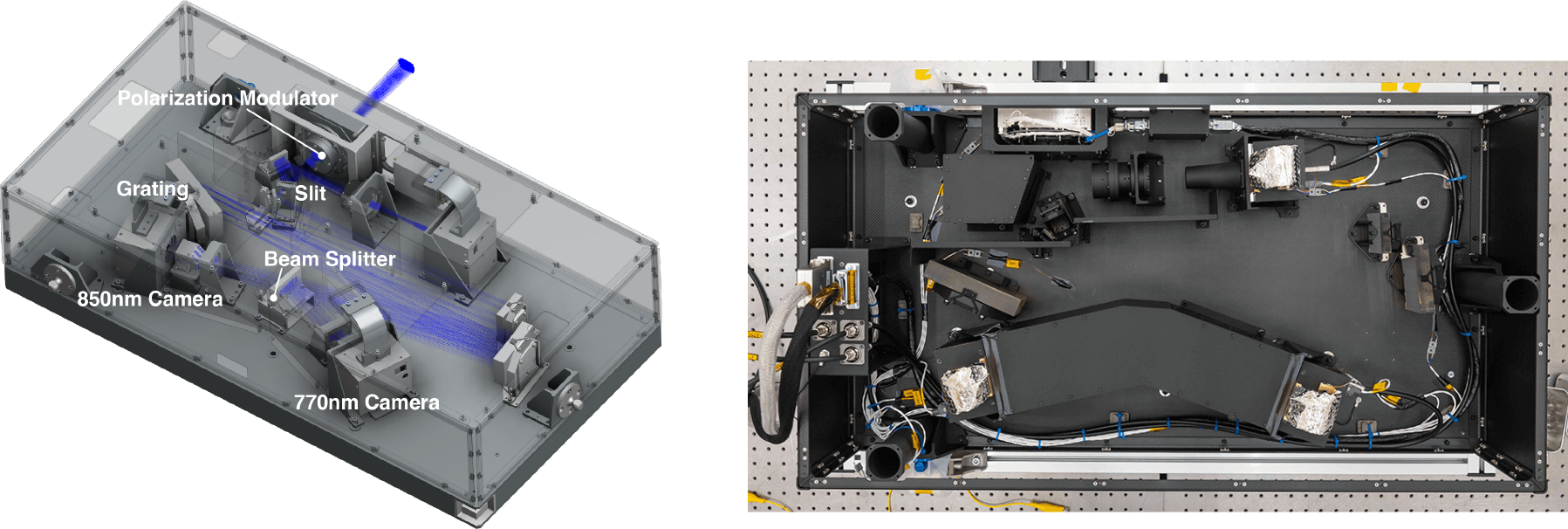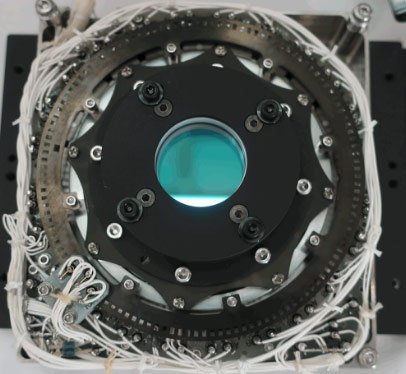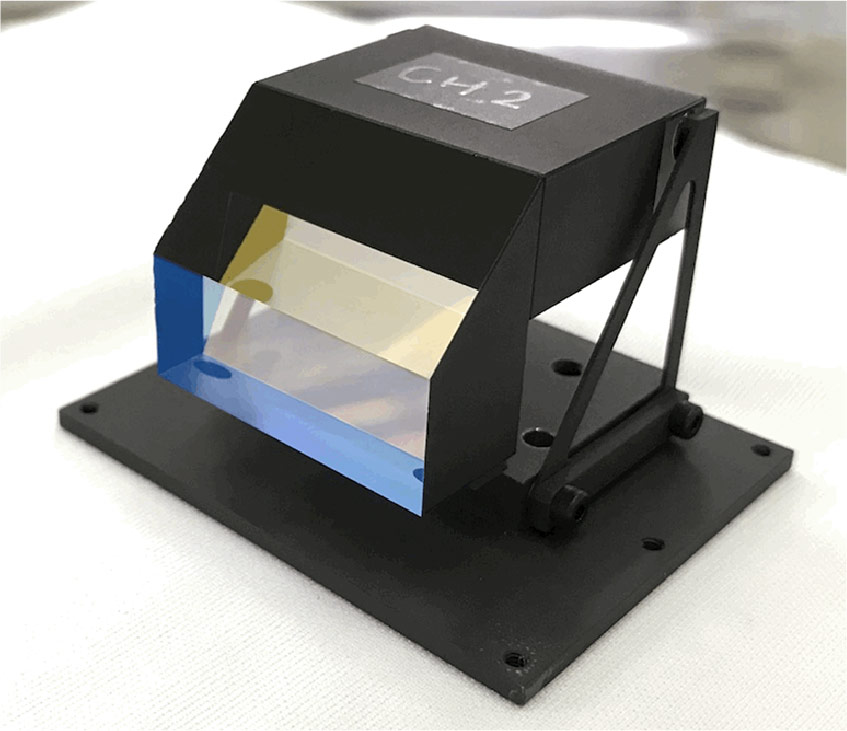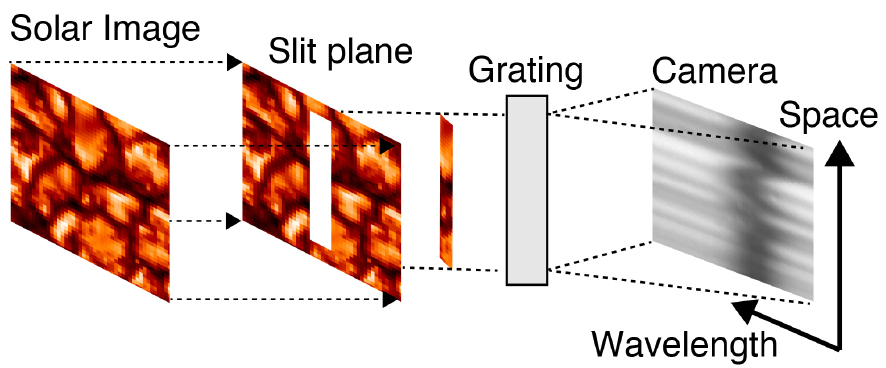

Instrument
About the instrument
Information related to the SCIP (Sunrise chromospheric Infrared spectroPolarimeter) instrument is presented here. Light reflected by the 1-meter diameter primary mirror of SUNRISE-3 is guided into the instrument through reflections in several mirrors in such a way that only near-infrared light reaches SCIP.
Performance
In this section, the performance information related to the SCIP instrument is described.
The spatial resolution of SCIP (0.2 arcsec) is roughly 300 times better than human eyesight. Since 1 arcsecond is 1/3600 degrees, it is possible to discern strutures of 0.00006 degrees on the solar surface. The light emitted from the fine strutures is observed simultaneously in two near-infrered bands (770 nm and 850 nm). The light in these two bands is split into 4 nm ranges and observed separately. Even more, it is possible to determine the polarization of the observed light at each wavelength. With the typical observation process of SCIP, the polarization can be fine measured with an accuracy of 0.03 %. For this accuracy, the information of the magnetic field can be obtained down to 5 gauss in the chromosphere and 1 gauss in the photosphere. The observation covers a maximum area of 58 arcsec x 58 arcsec.
Elements of Polarization Spectroscopic Observation with SCIP

Rotating Waveplates and Polarizing Beam Splitters
Light has wave-like properties, and "polarization" refers to the direction in which the light oscillates. Usually, light coming from the sun oscillates evenly in various directions, but light from the solar atmosphere with strong magnetic fields is characterized by oscillations oriented towards specific directions. By measuring this orientation, we can interpret the nature of the magnetic field in the solar atmosphere. SCIP uses a rotating waveplate to measure the polarization of the light. The waveplate changes the oscillation direction of light. For example, light oscillating horizontally is shifted to oscillate in the vertical direction. Since the waveplate is continuosly rotating, the degree in which the oscillation direction is changed depends on when the light strikes the waveplate. The light then reaches the polarization beam splitter, which allows only to pass through light oscillating in a specific direction. Therefore, the light recorded by the camera becomes brighter or dimmer, depending on the extent of the change in the oscillation direction. We can determine the initial polarization state based on this brightness level.


Slit and grating
On the slit plane, there is a small and thin rectangular hole (slit). When light strikes this surface, it can pass only through the slit, so nothing but vertical light goes beyond the slit plane. This one-dimensional light reaches a difraction grating (Grating), which disperses and reflets the light in the wavelength direction. Here, the vertical light (one dimension) is dispersed horizontally and becomes two-dimensional light. However, the two dimensions here are not vertical and horizontal space, but vertical space and wavelength. In this way, although we would like spectroscopic data (three-dimensional information: two spatial dimensions and wavelength), the camera can only capture two-dimensional light at once, so beforehand, it is necessary to extract one-dimensional only light with the slit.

Wavelength division filter camera
The filter has the property of transmitting the light in the 850 nm band and reflecting it in the 770 nm band. In order to observe separately both wavelength bands at the same time, two cameras are positioned so that both capture images.
Scan Mirror Mechanism
If the light transmitted through the slit is imaged as described above, only one-dimensional light can be captured. However, the solar image that we actually want to capture is spread out over a two-dimensional space. Then, by changing the the solar image transmitted through the slit, we can obtain two-dimensional space data. The Scan Mirror Mechanism is in charge of this function. By tilting the mirror slightly, the position of the reflected image can be shifted. The Scan Mirror Mechanism is positioned just before the light enters SCIP, so it can change the one-dimensional light passing through the slit. By repeating this operation many times, we can obtain (polarized) two-dimensional space spectral data.

Optical design for high spatial and wavelength resolution
To maximize the performance of the 1-meter aperture SUNRISE-3 balloon-borne telescope, SCIP employs many techniques to prevent the distortion of the light wavefront. The surface of the two aspherical mirrors, which is the core of the optical system, is extremely precise with 6 nanometers (RMS) distorsion. In the filter that splits the light path into two within SCIP, the optical elements are slightly distorted due to the different coatings applied on both sides, however the deformation is cancelled by fine tuning the thickness of the compensation film. By these design innovations of the optical system and optical elements, the distorsion of the light wavefront produced by the entire optical system is minimized.
